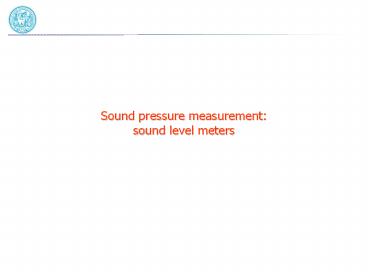Sound pressure measurement: sound level meters
Title:
Sound pressure measurement: sound level meters
Description:
Title: ELETTRONICA INDUSTRIALE Author: Paolo Pavan Last modified by: farina Created Date: 9/14/2003 3:15:00 PM Document presentation format: On-screen Show –
Number of Views:177
Avg rating:3.0/5.0
Title: Sound pressure measurement: sound level meters
1
Sound pressure measurementsound level meters
2
The sound level meter
3
Structure of a sound level meter
The SLM contains a preamplifier for adjusting the
full scale value, a weighting network or a bank
of pass-band filters, a true RMS detector which
can operate either with linear averaging over a
fixed measurement time, or a running exponential
averaging with three possible time constants,
and a display for showing the results.
4
The Equivalent Continuous Level (Leq)
The continuous equivalent level Leq (dB) is
defined as where T is the total measurement
time, p(t) is the instantaneous pressure value
and prif is the reference pressure
- Leq,T ? dB (linear frequency weighting)
- LAeq,T ? dB(A) (A weighting)
- Please note whatever the frequency weighting, an
Leq is always measured with linear time weighting
over the whole measurement time T.
5
running exponential averaging Slow, Fast,
Impulse
- Instead of measuring the Equivalent Level over
the whole measurement time T, the SLM can also
operate an exponential averaging over time,
which continuosly displays an updated value of
SPL, averaged with exponentially-decaying
weighting over time according to a time constant
TC - in which the time constant TC can be
- TC 1000 ms SLOW
- TC 125 ms FAST
- TC 35 ms for raising level, 1.5 s for falling
level IMPULSE - In exponential mode, a SLM tends to forget
progressively past events - Instead, in linear mode, the result of the
measurment is the same if a loud event did occur
at the beginning or at the end of the measurement
time
Lin, 1s
1
SLOW
t
6
Calibration at 1 Pa RMS (94 dB)
The calibrator generates a pure tone at 1 kHz,
with RMS pressure of 1 Pa
7
SPL analysis of a calibrated recording
The software computes a time chart of SPL with
the selected time constant































